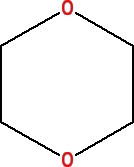1,4-Dioxane
Safety Information
Concerns initially were raised in the 1970s, when studies at the National Cancer Institute found an association between1,4-dioxane administered at high levels in the feed of laboratory animals and cancer. However, the levels that are observed in some cosmetics and personal care products are far lower [several thousand times lower] than those found to be harmful in the feeding studies.
As a precaution, FDA followed up with skin absorption studies, which showed that 1,4-dioxane can penetrate animal and human skin when applied in certain preparations, such as lotions. However, further research by FDA determined that 1,4-dioxane evaporates readily, further diminishing the already small amount available for skin absorption, even in products that remain on the skin for hours.
While FDA has not independently conducted a hazard identification and risk assessment concerning exposure to 1,4-dioxane at low, trace levels in cosmetic products, based upon their findings to date, FDA has not determined a need to set limits for 1,4-dioxane in cosmetics and personal care products. FDA’s website states that they will continue to monitor information about 1,4-dioxane and its levels in cosmetics. If they were to determine that a health hazard exists, they would advise the industry and the public, and would consider appropriate actions for protecting the health and welfare of consumers.
In 1988, 1,4-dioxane was added to California’s list of chemicals known to cause cancer under the Proposition 65 regulations. As part of the Proposition 65 regulations, however, California has established levels at which listed chemicals would not be considered a risk to consumers. These “Safe Harbor” levels are set through a rigorous scientific process in which the potential hazard of a substance is assessed and the information is used to set a safe level. The safe level set for 1,4-dioxane is 30 micrograms/day. The trace levels of 1,4-dioxane that may be present in some cosmetics or personal care products are well below this safety limit.
The EU Cosmetics Regulation lists 1, 4-dioxane in Annex II as a prohibited substance. However, the EU regulation also states that the non-intended presence of a small quantity of a prohibited substance, stemming from impurities of natural or synthetic ingredients, the manufacturing process, storage, migration from packaging, which is technically unavoidable in good manufacturing practice, shall be permitted provided that such presence is safe for human health when used under normal or reasonably foreseeable conditions of use.
The EU’s Scientific Committee on Consumer Safety (SCCS) conducted a review of a 1,4-dioxane risk assessment performed by the International Cooperation on Cosmetics Regulation (ICCR) and concluded that trace levels of 1,4-dioxane in cosmetic products of ≤10 ppm are safe.
